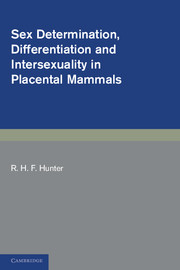Book contents
- Frontmatter
- Contents
- Preface
- Acknowledgements
- List of abbreviations
- List of gene abbreviations
- 1 Historical landmarks in studies of reproduction and sex determination
- 2 Mechanisms of sex determination
- 3 Differentiation of the gonads
- 4 Differentiation of the genital duct system
- 5 Anomalous sexual development in domestic species
- 6 Abnormal sexual development in laboratory rodents
- 7 Abnormal sexual development in man
- 8 Sexual differentiation in chimaeras
- 9 Asymmetries in the reproductive system and their significance
- 10 Concluding thoughts and a current perspective
- Index
- Plate section
1 - Historical landmarks in studies of reproduction and sex determination
Published online by Cambridge University Press: 05 March 2012
- Frontmatter
- Contents
- Preface
- Acknowledgements
- List of abbreviations
- List of gene abbreviations
- 1 Historical landmarks in studies of reproduction and sex determination
- 2 Mechanisms of sex determination
- 3 Differentiation of the gonads
- 4 Differentiation of the genital duct system
- 5 Anomalous sexual development in domestic species
- 6 Abnormal sexual development in laboratory rodents
- 7 Abnormal sexual development in man
- 8 Sexual differentiation in chimaeras
- 9 Asymmetries in the reproductive system and their significance
- 10 Concluding thoughts and a current perspective
- Index
- Plate section
Summary
Introduction
These opening pages represent no more than the briefest survey of highlights upon a canvas extending from the speculations of classical antiquity to the findings of contemporary molecular genetics. The viewpoint offered is, of course, a personal one and there is little doubt that other authors would – in part at least – have focused on different events and different material. In this regard, inspection of some of the volumes cited as references should give access to alternative interpretations and indeed to modified historical perspectives. Readers may perhaps detect a certain partiality towards contributions from the University of Edinburgh in the last portion of this short chapter. Taking into consideration the author's earlier connections with this institution (see Preface), and its extensive influence in the field of mammalian reproductive physiology, then it is hoped that the significance of the studies mentioned will not be judged as completely inappropriate.
Ancient Greek philosophers
As discussed by Short (1969), the dual problems of sex determination and sexual differentiation have fascinated mankind since the dawn of history, and sexual abnormalities of one sort or another have become the centrepiece of many a legend and fable. Primitive man undoubtedly had a keen appreciation of the vital parts of the anatomy, this being well illustrated in cave paintings, carvings, and frequently in the nature of mutilations inflicted upon rivals. Anomalous sexual anatomy certainly attracted attention and sometimes even social esteem, a situation which has persisted in some cultures up to the present day.
- Type
- Chapter
- Information
- Publisher: Cambridge University PressPrint publication year: 1995
- 1
- Cited by

